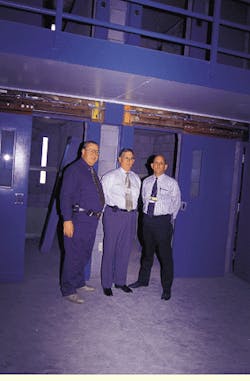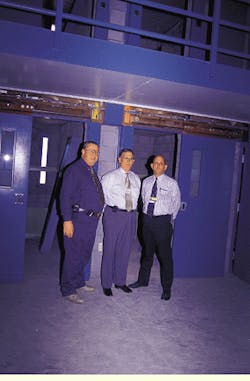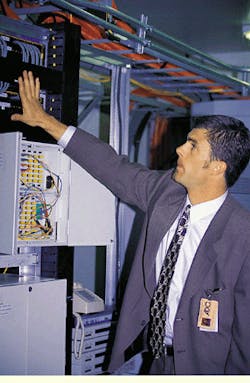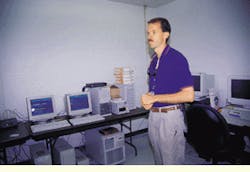A fiber-optic infrastructure makes the prison one of the most technologically advanced in the U.S.
Ed Wiencek
Chromatic Technologies Inc.
Carol Shafer Everett
Everett Communications
Unfortunately, building prisons is a growing business. We are filling them as fast as we can build them," states James McFadden, warden of Arizona State Prison Complex-Lewis (ASPC-Lewis). "During the last 10 years, the Department of Corrections has added more than 12,000 beds, doubling the state`s inmate capacity to nearly 26,000. Arizona has one of the highest inmates-per-capita population in the United States," he adds.
Today, Arizona has 12 prison complexes and continues to construct more. The newest prison, ASPC-Lewis (Buckeye, AZ), is named after retired director Samuel A. Lewis. The six units are named for officers who have died in the line of duty. "Lewis Prison, which sits on 1584 acres, is a city in itself," says McFadden. "The site supports its own wells and wastewater treatment plants, engineering plant, electrical plant, generators, fire department, education system, and 44 acres of agricultural fields. It is also one of the first to incorporate an extensive fiber-optic-based infrastructure to support our own advanced LAN [local-area-network] and WAN [wide-area-network] system for voice, data, video, and security."
McFadden was instrumental in the design and development of the new complex. He wanted to make sure that this prison would make use of the newest technology to forestall obsolescence. "When prisons are built, they are built for the long haul--at least 50 years," he notes. "Installing the proper cabling infrastructure is key to a prison`s operation. Not only do we need the capacity to handle massive prisoner files, as well as an extensive security system, but also if our cable becomes outdated, that means pulling out and installing cables through our solid grout and rebar construction--not an easy task. Fiber is real time and allows all control of data, voice, video, security, and other instrumentation from one control room, versus one per building."
"Another important aspect when designing a prison is making sure that the prisoners stay inside the prison. I am not only talking about the security around the perimeter; I am talking about limiting the number of times a prisoner has to be transported outside this facility," explains Gary Mitchell, telecommunications manager for the Arizona Department of Corrections (ADC). "It is our business to keep the inmates away from the public. For example, whenever a prisoner needs special medical attention, we have to take him outside to a specialist. With a sophisticated fiber-based system, we can now access telemedicine through electronic files and video broadcast. We can transfer all medical records as well as the other files on all inmates within this prison and between other prisons."
The benefits of a fiber-based system for the complex are numerous. Since there was just one chance for the project to be designed and installed efficiently, Mitchell and the ADC communications team had to pick the right team of system designers, suppliers, and installers to work with the general contractor. They chose NetCom Management Group (Phoenix) to install the lan/wan networking and the cable-TV and telephone systems. NetCom specified both singlemode and multimode fiber-optic cable from Chromatic Technologies Inc. (Franklin, MA), which was supplied through its Phoenix stocking distributor, Communication Supply Corp. (CSC--Phoenix).
Twenty-seven different contracting companies took part in the construction of the complex. At the height of construction, there were 1107 contractors on-site in one day. Significant cost savings were realized because each building was identical to the next. Although the original construction plans called for the buildings to be built one at a time, the ADC decided to build the last in tandem to cut costs. In addition to using one design, revised plans consolidated all six prison units into a smaller land area, thereby reducing installation costs of utilities, lighting, roads, and of course, the networking system.
Costs were also cut by using significant inmate labor for fence work, cement pouring, plumbing, and some light electrical work. "You wouldn`t believe the tradesmen we have as prisoners. We use their skills and also pay them," says the warden. "We may not be as fast as a general contractor, but we are just as good.
Tight security
Because of the unique environment of high security in prisons, each contractor and contracting company went through extensive background checks. Once a person passes clearance with the ADC, he is cleared for future prison jobs.
"When most people consider cabling in this environment, they only imagine applications to include computers, phones, and possibly video security cameras. That is just a small part of all the applications that a cabling system performs in a prison," explains Scott Tubbs, director of sales, engineering, and marketing for NetCom. "In addition to the phone, computer, cable TV, and EMR [electronic medical records] transfer, we had to specify a cabling system that could handle some special indoor and outdoor requirements. These requirements include unique functions of cable signaling, such as the perimeter detection system whereby buried cable sends out an alarm if someone gets too close to the fence. Signal control also includes the water-controlling devices that prevent inmates from over-flushing and causing flooding as well as limiting water used in sinks. To handle the multitude of fiber-optic cable applications, we specified RLTB, an indoor/outdoor loose-tube, gel-filled, single-jacket design, in both multimode and singlemode."
Digging in and out
The entire cabling system is installed in conduits. To get the cabling to the perimeter of the prison property, they had to install 21/2 miles of conduit from the nearest utility intersection. "Throughout the prison grounds, there are 1200 miles of conduit. There is enough PVC conduit to create an electrical super highway between this site and Los Angeles," notes John King, administrator of the ADC`s information-systems services branch.
For the backbone, Chromatic produced a composite cable in one loose-tube jacket to include 24-strand multimode and 24-strand singlemode cable to the main crossconnect, known as the MPOP (main point of presence). The original plans called for four conduits to the main crossconnects in each of the six units, but that number was increased to six conduits. "We need more because of our unique environment and the longevity of our buildings," says McFadden. "So, we have to be more forward in our thinking to come up with raceways and pathways to get whatever will be the newest and greatest applications in the next 10 years."
In addition, the ADC proposed to install two conduit systems--one for the present and one for future emergencies. "That`s a lot of conduit in a 4-square-mile complex, but it wasn`t much more work to install side-by-side conduit rather than install it at a later date," says Mitchell.
Installing a large-scale conduit and cabling system was a learning experience for the installer, general contractor, and the ADC. The manholes were dug lower than the ground and throughout the monsoon season the manholes then acted as drains. "My biggest fear was that if those duct banks flooded, they would go right up to the computer rooms and ICs," remarks Tubbs. "With the help of the inmates, we either blew the rain out of the conduits or used pumps that we brought on sight. In the future, we will specify the conduit system have some space conduits plugged."
Although the outdoor conduit system was not installed by NetCom, the intrabuilding conduit system was installed by the general contractor, due to the strict building requirements of the ADC. Once the building was constructed, it was then turned over to NetCom to install the cable and cable-management system. "There was only one building where the conduit pathway didn`t match my plans. We had to drill through about six cement walls for 180 feet of conduit. Because of strict building codes for a prison, you just can`t free air conduits. There is very little exposed conduit in the Lewis prison facility," says Tubbs.
Making an entry
At the building entrances, the cables were wrapped in a plastic spiral wrap to protect them and make pulling the cables to the closets easier. "The main advantage of the RLTB cable, which was manufactured for this site, is that it is designed for both outdoor and indoor applications, eliminating a splice point at the building entrance. It can run beyond the 50-foot limit required by the National Electrical Code to the termination closet," explains Gleason Gallagher, vice president and general manager for Chromatic. "In addition, the RLTB cable is riser-rated--type OFNR--and can run directly to a network hub or splicing closet for interconnection to the hardware equipment or other horizontal distribution cables with no extra splice or terminations. This is a cost savings in labor."
Chuck Fortino, sales representative for CSC, adds, "CSC made a significant commitment to NetCom by supplying close to $750,000 worth of inventory in the local warehouse for the ASPC projects. We supported NetCom by providing them with the cable they needed, cut to length, and labeled to their explicit instructions. We also inventoried and staged all of the material for each prison unit to help NetCom manage the vast amount of material required for this project."
From the MPOP, composite cables containing 24 multimode and 24 singlemode fibers went to each of six main crossconnects. There, they were spliced into the fiber cabinets and then a hybrid 12-multimode/6-singlemode cable was pulled to each intermediate crossconnect (IC), leaving spare fibers for future use. There are a total of 50 ICs in the complex, which encompasses the six prison housing units and administration buildings.
NetCom developed custom fiber boxes for splicing in the ICs, which were also the electrical rooms. "Unfortunately, we were given space in electrical rooms, which is a 1980s technology, and we had to take that smaller area and put in technology for the next millennium," reports Tubbs. NetCom did manual termination of 2500-multimode and 1800-singlemode fiber.
The applications for the multimode fiber include data and voice. Singlemode fiber is used for cable TV, video, telemedicine, and other applications that require large amounts of bandwidth. "The ICs are running 100Base-T Ethernet over the fiber-optic cable," says Mitchell. "From the closets to the 2000 data drops, we are running Category 5 copper over 10Base-T. The copper connections were terminated to Ortronics cable-management racks and patch panels in the ICs. For each workstation outlet, we are using Ortronics TracJack outlets, which include two data and one voice as specified to the outlet and a blank port for future applications. To update to fiber-to-the-desk, we will install network interface cards in the computers and update the switches in the ICs."
No house calls needed
The vast computer network at the complex is administered from outside the prison gates. One person, Shane Allen, network administrator for ASPC-Lewis, staffs the 1400-sq-ft office. He is responsible for the small server farm encompassing a mixture of Novell and Microsoft NT servers and more than 600 client personal computers. The LAN provides the officers, administration, and medical staff with electronic inmate record information, Internet e-mail, word processing, and desktop publishing.
"Remote management is the key to running this vast LAN," states Allen. Typical service calls of the past would mean either assisting the client over the telephone or passing through as many as six different gates just to get to the client`s PC. By using such products as Novell`s Z.E.N. Works and Managewise, Allen is able to remotely control the client PC from any location and "see" the problem, which limits most trouble calls to fewer than five minutes without having to visit the client. Likewise, Novell`s Managewise can monitor the LAN and server health. "Detecting problems early keeps me ahead of the network, not playing catch-up. The least of my worries is the fiber-optic backbone," says Allen. "The quality of the cable and its installation make it a true `backbone` that can be relied on for years to come."
In selecting fiber for the backbone, 50-micron fiber was considered in addition to the more common 62.5-micron fiber. Because of chromatic dispersion and higher resolution, the smaller core in 50-micron fiber is better for higher bandwidth in longer runs. "We reviewed our cable runs and calculated whether the prison required extra bandwidth to install the smaller 50-micron fiber rather than the standard 62.5-micron," relates Tubbs. "The change to 50-micron fiber would have required changing all the peripherals such as the routers, hubs, and servers. The cost difference would have been minor, but in the end, we decided to stay with the 62.5-micron fiber because it is a more accepted standard and therefore could meet the industry`s warranty testing. When we used the optical time-domain reflectometer to test the installed fiber, there was not one failed strand. There are 40 miles of fiber-optic cable. If you total this per strand of fiber, we`re talking about thousands of miles."
Even with the intricate cable-TV, phone, and security applications, the cable installation was completed three months ahead of schedule. "We installed 6000 cable-TV hookups with fiber-optic cable for the backbone. There is not one coaxial cable for cable-TV transmission, only RG-6 station cables for connection," Tubbs says.
"The cable-TV system is designed for inmate education and notifications," adds Denis Brimhall, technical support manager with the ADC. "This is an addressable cable-TV system. We can shut off whole units. Shutting off units, which can be done in the main control room, is one way of punishing inmates for unacceptable behavior."
The cable-TV and main phone lines come into the complex through T1 1.554-megabit-per-second lines leased through US West. Pay phones located in the units are monitored. Prisoners have to submit a list of phone numbers. If a prisoner tries to call out to a number that is not on the pre-approved list, the database will not allow that number to be dialed.
Security applications are sophisticated. The palm-reader system records handprint identification through fiber-optic cabling. "Security is our top priority here," asserts McFadden. "In the future, we would like to have an electronic wristband tracking system for our inmates, but that technology has not come down in price for that.
"Many other states are looking to the Arizona prison system for the advanced technology installed at Lewis combined with the many cost-saving building techniques. ASPC-Lewis is one of the largest correctional facility endeavors in the United States and will prove to be a model for future facilities," predicts McFadden. "When looking at the success of Lewis, it has to be realized that this was a team effort between the Department of Corrections and all the players--from the general contractor through the reps, distributors, installers, manufacturers, and of course, to our own inmate labor."
James McFadden (center), warden at ASPC-Lewis, inspects the pneumatically controlled doors at a soon-to-be-occupied facility at the Lewis Prison complex. Pictured with him are deputy warden Gary Bulger (left) and assistant deputy warden Stan Bates (right).
Scott Tubbs, director of sales, engineering, and marketing for NetCom Management Group, explains the challenge of installing the communications and cabling termination equipment in the tight telecommunications closets within the complex.
Shane Allen, network administrator for ASPC-Lewis, manages the prison`s huge LAN without having to leave the control center.
Ed Wiencek is new-product development manager at Chromatic Technologies Inc. (Franklin, MA). Carol Shafer Everett is a technical writer for the cabling industry at Everett Communications (Ashland, MA).
Scott Tubbs, director of sales, engineering, and marketing at NetCom Management Group (Phoenix), contributed to this article.



